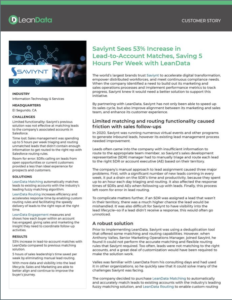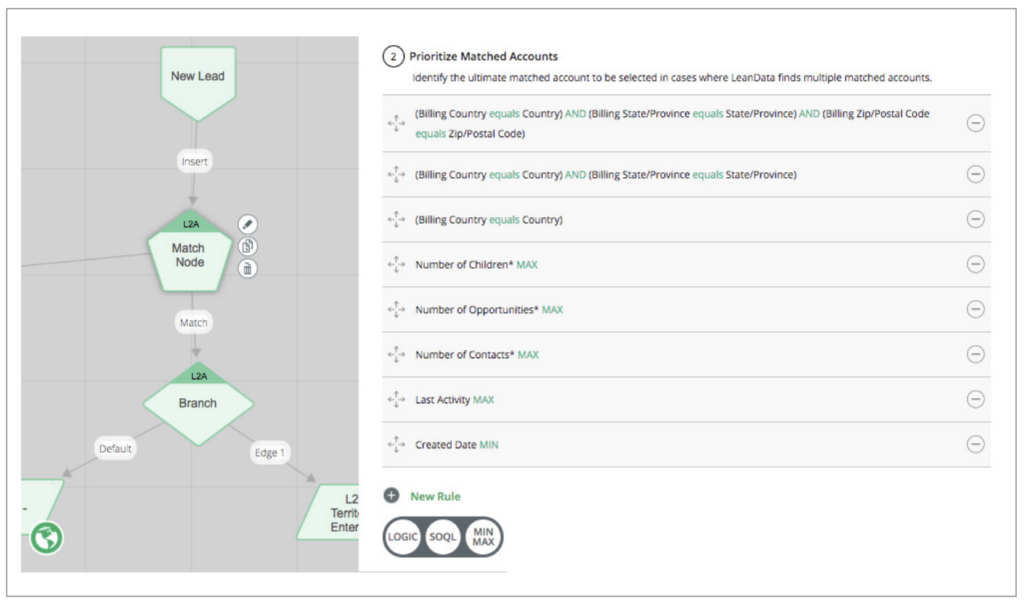As your organization grows, you come to know all too well the growing pains that accompany true go-to-market (GTM) success. To achieve this, your team’s outreach and engagement with prospects, leads and customers become critical to building their trust and confidence in your organization.
Therefore, when your team is invested in revenue generating activities, the last thing you want to see in your inbox is a prospect wondering why multiple reps are reaching out about the same topic. Or, even worse, a long time customer following up on an unanswered question. Instead of staying focused on value-added activities, your team is sent on a wild goose chase to track down relevant reps, correct Salesforce data or solve unanswered customer questions.
Each minute spent on these tasks is a minute lost to counterproductive efforts, drawing your reps away from the main business at hand — driving revenue for your organization.
Lead assignment to Sales reps lies at the heart of every GTM process. But when your organization’s routing processes are erred, you become vulnerable to significant downstream issues, including:
- Routing leads who’ve already engaged with a Sales rep to a different rep at your company
- Assigning leads to a Sales rep before updating it with contextual account information
- Directing leads tied to an existing customer account to a different Sales rep rather than the Account Executive
- Assigning leads tied to an open opportunity owned by an Account Executive to a different Sales rep
Any of the above examples can have dire effects, the least of which is a poor customer experience. But, before refining your lead assignment process, it’s important to first optimize your lead-to-account (L2A) matching process.
What is lead-to-account matching?
At its core, lead-to-account (L2A) matching is an automated process for connecting leads and contacts to their associated accounts in Salesforce. It relies on logic to identify leads who belong to existing accounts and provide reps the contextual information they need to make meaningful engagements. Tagging relevant account data to matched lead records is also powered by L2A matching, opening the door to contextually rich segmentation and personalization.
Through these capabilities, L2A matching is the critical first step for any GTM motion, enabling Sales and Marketing to execute account-based (ABM) strategies with efficiency and confidence.
How lead-to-account matching is performed
While L2A matching can be performed manually in Salesforce, it’s impossible to sustain as your organization grows and time becomes a precious currency. To keep your team on track, automated L2A matching solutions give you the speed and context to engage leads sooner and remain focused on key revenue generating activities.
LeanData’s industry-leading automated L2A matching solution is built upon its best-in-class fuzzy matching algorithm (also known as approximate string matching), connecting leads to accounts within Salesforce. LeanData fuzzy matching looks beyond basic email domains and ensures the highest fidelity by matching based on multiple fields, including:
- Individuals’ names
- Company/Account
- Website
- Phone
- Address/Location
Moreover, LeanData’s fully customizable tiebreakers provide complete control over which account is the best match, allowing you to navigate complicated parent-child hierarchies, as well as control for duplicate accounts.
Lead-to-account matching in action
In 2020, Saviynt, a leading provider of intelligent identity management technology, ran numerous virtual events and other programs to generate inbound leads. However, with the influx of leads, the company quickly discovered its existing lead management process needed improvement.
Leads often came into the company with insufficient information to route to the appropriate team member, requiring Saviynt’s sales development representative (SDR) manager to manually triage and route each lead to the correct SDR or account executive (AE) based on territories.
Saviynt’s manual approach to lead assignment created four problems:
- Sheer lead volume led to the SDR manager spending up to an hour a day triaging and routing, constricting time and productivity
- Routing delays hindered speed to lead, impeding on quick response times from SDRs and AEs
- Manual processes left room for routing errors, increasing the likelihood of a lead being mishandled later downstream
- Poor visibility into the lead lifecycle prevented the team from identifying occasions where a lead wasn’t responded to
Further complicating matters, when SDRs were assigned leads that weren’t in their territory, the chances the lead would be mishandled grew substantially.
At the time, Saviynt was also using a deduplication tool that offered limited matching and routing capabilities, inhibiting the company from obtaining the accurate matching and flexible routing it required. As a result, leads weren’t matching to the right accounts and a great deal of customization was needed to make its solution workable.
Seizing the opportunity

Immediately, Saviynt saw a 53 percent increase in leads matched to accounts with LeanData Matching compared to its previous matching tool. Sales leadership is additionally saving five hours a week by eliminating manual lead management and routing. Most importantly, its SDRs are continuing to receive more of the right leads and focusing their energy on those follow ups.
For more detailed information, please read the case study, “Saviynt Sees 53% Increase in Lead-to-Account Matches, Saving 5 Hours Per Week with LeanData.”
“That Matching piece is big for us. With LeanData, it’s just like night and day compared to what we were able to accomplish before.”
~ Anthony Valles, Senior Marketing Operations Manager, Saviynt
Driving go-to-market success
Automated lead-to-account matching and routing solutions not only increase speed to lead and quicken the sales cycle, they also improve alignment between Sales and Marketing teams, empowering the delivery of an enhanced customer experience.
The only place in your GTM motions for manual processes is in selling-related activities. Look to increase your efficiency, and therefore your effectiveness and productivity, by investing in automated solutions that empower your revenue teams to do what they do best.









